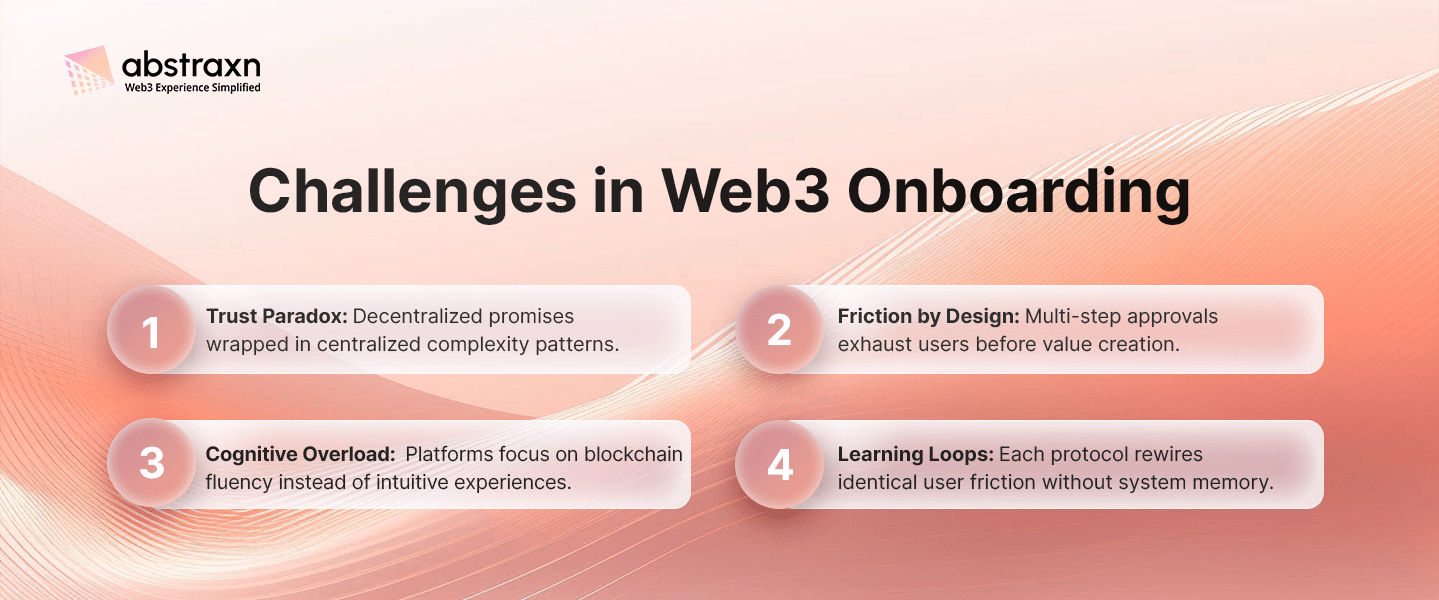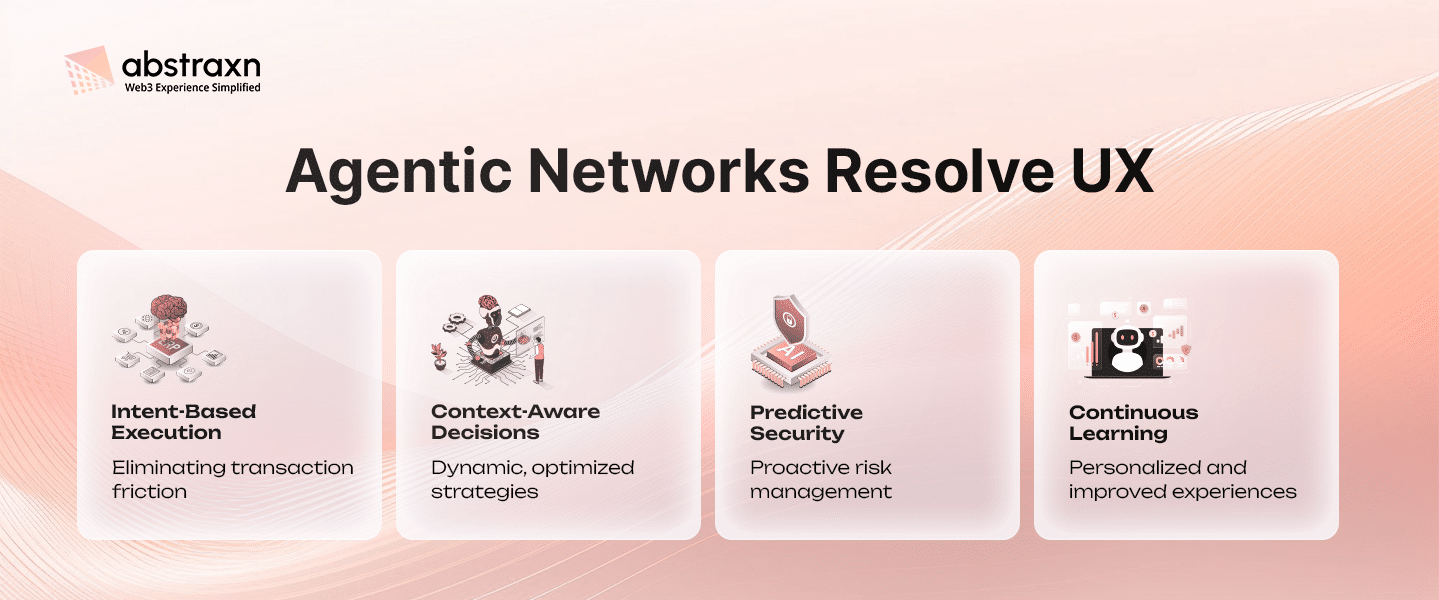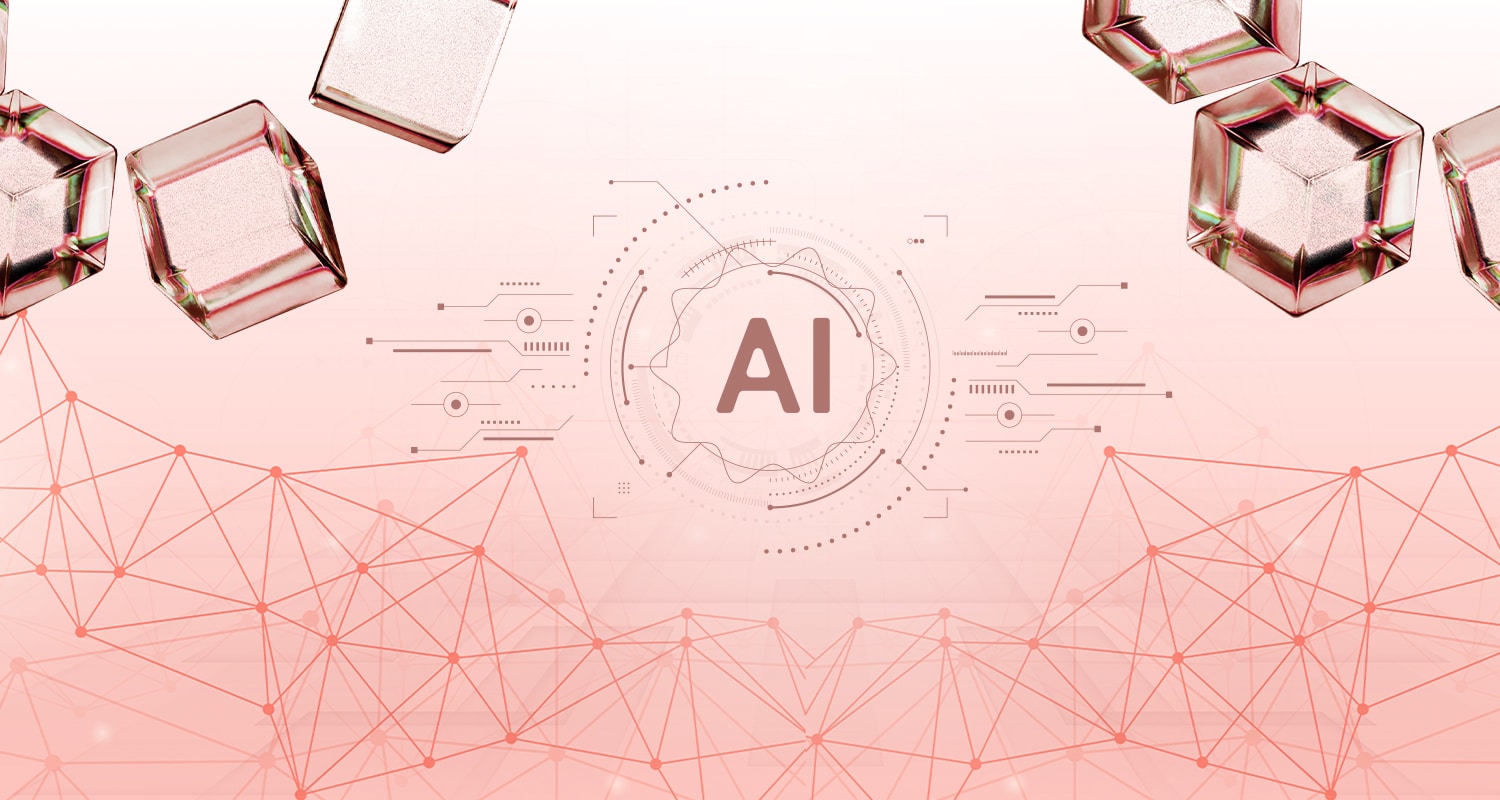A first-time user confronts a series of blockchain jargon – wallet connections, signature approvals, complex gas calculations, network switching prompts, and so on. Overwhelmed, they close the browser tab!
That accounts for 40% of the users who never return after their first wallet interaction. Most of the transactions fail from user surrender rather than technical errors.
Now, let’s bring agentic AI into the equation: If the same person simply types “Convert $100 USDC to ETH at the best available rate.” And the entire transaction process completes in a few seconds – smoothly and easily, without any other step.
This contrast reveals Web3’s defining split: platforms still demanding users to navigate blockchain complexity and those where autonomous agents tackle execution while users simply express intent.
Why Web3 Onboarding Remains Broken

Behind those dismal retention numbers are deeper architectural bottlenecks: Web3 platforms see blockchain complexity as a user awareness challenge rather than a design flaw.
Approval Gauntlet: All intent-based crypto transactions demand what industry insiders call “the approval gauntlet” – a series of complicated steps that exhaust even seasoned DeFi veterans.
Interface Intelligence Gap: Current platforms operate on a backward approach that requires users to adapt to blockchain mechanics rather than blockchain mechanics adapting to users. In this scenario, interfaces induce context-free decision making – slippage tolerance, gas limits, bridge routes – without providing the right knowledge to make optimal choices.
Trust Execution Conflict: It won’t be incorrect to say that Web3 assured trustless systems but offered trust-intensive experiences. Users have to assess the risks of smart contracts, verify protocol legitimacy, and manage their private keys – cognitive burdens that pile up with every new interaction.
Knowledge Void: Web3 platforms are constantly reinventing the wheel. Hard-won UX insights disappear with team turnover, forcing each protocol to rediscover identical friction patterns.
Without a coordinating layer that interprets goals, platforms keep exchanging one set of friction points for another. This is why many teams report lost conversions.
Abstraction Worked, But Gaps Remain
Account abstraction came up as the Web3 industry’s hope for mainstream adoption. It masks blockchain complexity behind smart accounts, removes gas fee friction through paymasters, and bundles transactions for efficiency. Yet despite its widespread implementation, user retention continues its stubborn decline.
The Static Intelligence Problem
Typical smart accounts in crypto operate on predetermined logic – rules that execute when specific conditions are met. This is a significant step forward from manual wallet management, but it also assumes that user needs are predictable and contexts are static.
For cross-chain bridging. Account abstraction can automate the technical mechanics through the relayer and bundler architecture: bundling approvals, managing network switches, and handling gas sponsorship. Paymaster agents sponsor transaction costs, thus eliminating immediate friction. But these systems cannot dynamically assess which bridge offers optimal timing, lowest slippage, or best route based on current market conditions. Users still must research, compare, and decide – the cognitive burden simply shifts rather than disappears.
For instance, a user looking for “maximum yield on stablecoins” faces identical friction whether using traditional wallets or abstract accounts. Both require manual protocol research, risk assessment, yield comparison, and continuous portfolio monitoring.
The Reactive Limitation
Current abstraction solutions respond to explicit user instructions but cannot anticipate needs or optimize proactively. They show sophisticated automation rather than actual intelligence.
When network congestion spikes, smart accounts execute transactions at user-specified parameters rather than adapting strategy. When better opportunities emerge across protocols, users must monitor and manually migrate positions.
This reactive paradigm restricts autonomous intelligence to infrastructural optimization while leaving strategic decision-making completely on human cognition – this is where Web3 friction originates.
Introducing the Concept of Agentic AI Network
Now, the solution isn’t better abstraction – it’s intelligent abstraction!
What is Agentic AI?
It represents the evolution from reactive automation to proactive intelligence, where Web3 agents don’t just execute predefined rules but interpret intent, evaluate context, and optimize results in real-time.
From Commands to Conversations
Conventional interfaces require users to translate intent into blockchain-compatible instructions. Agentic AI inverts this paradigm entirely. Users state their obvious intent: “stake my ETH for the highest yield with the lowest risk” and Web3 AI agents convert it into optimal on-chain execution. It’s contextual intelligence that considers current market conditions, gas optimization, risk assessment, and portfolio implications simultaneously. The user sees the strategy; the agent thinks tactically.
The Intelligence Layer Architecture
AI agents in Web3 form a distributed cognitive network above blockchain infrastructure. Unlike monolithic systems, agentic networks utilize specialized agents for distinct functions, such as Information Agents for protocol guidance, Transactional Agents for optimized execution, and Security Agents for real-time risk assessment.
This distributed approach implies autonomous intelligence that scales through specialization rather than attempting to solve every problem with a single system.
How Agentic Networks Eliminate UX Friction
While abstraction automates processes, agentic intelligence automates decisions. This distinction resolves Web3’s core friction points at their very cognitive source.

Intent Replaces the Approval Gauntlet: Instead of navigating wallet connections, signature requests, and gas calculations, users simply state their objectives. AI in Web3 interprets “bridge my tokens to Polygon for the lowest cost” and carries out fee management, optimal routing, and timing itself. The cognitive burden transfers from the user to the agent.
Context-Aware Decision Making: When users seek “maximum stablecoin yield,” agentic networks don’t just execute – they check current protocol rates, assess risk profiles, and look for better opportunities. Unlike static smart contracts, Web3 AI agents adapt strategies based on the constantly evolving market conditions.
Predictive Risk Management: Rather than reactive security alerts, agentic networks extend proactive protection. They scan contracts before interaction, monitor for emerging threats, and implement defensive measures automatically. Users gain institutional-grade security without institutional complexity.
Continuous Optimization: Agentic networks consistently learn and improve. They accumulate insights from every interaction, refine decision-making algorithms, and personalize experiences based on user preferences. The knowledge void that mars current platforms becomes a competitive advantage as agent intelligence compounds over time.
Why This Matters Right Now: The Strategic Inflection Point
The time for introducing agentic intelligence in Web3 is not tomorrow; it is today! In other industries, this shift is already table stakes. In finance, autonomous agents manage portfolios and execute trades based on high-level strategy. For smart homes, agentic networks devise climate, entertainment, and security systems from just a single command.
For the forecast period 2025 – 2034, the global agentic AI sector size is projected to be nearly USD 196.6 billion by 2034, from USD 5.2 billion in 2024, increasing at a CAGR of 43.8%.
Users now arrive at Web3 with this expectation of seamless and intelligent interactions. To meet them with a wallet connection pop-up is not just a poor experience – it is a strategic failure. Legacy UX woes are hardening into permanent barriers, conditioning a generation of users to believe that complexity is the price of entry. We must act before this perception becomes permanent.
The ecosystem will only unlock genuine and mainstream scale when we stop asking users to interface with our infrastructure and start allowing them to interact with their intent. Deploying AI agents in Web3 isn’t adding a feature – it’s installing the foundational cognitive layer that was always missing. The platforms that build on this layer won’t just acquire users – they will captivate and retain them.
From “Why” to “How”: Realizing AI in Web3
The critical question remains: “how”?
How do we transition from theoretical architecture to shipped product? How do we weave together the specialized agents – the intent parsers, the yield scouts, the security sentinels, the gas optimizers into a cohesive and reliable network? And most importantly, how can platforms integrate this intelligence without needing a dedicated AI research team?
We have answered this with Abstraxn. Our platform stitches together the essential infrastructure – relayers, bundlers, paymasters – with a sophisticated network of specialized AI agents, creating a seamless B2B solution. In the next article, we will reveal how Abstraxn’s agentic network operates, embedding intent-driven journeys in minutes, not months.
Stay tuned for more. The conversation has just begun!




